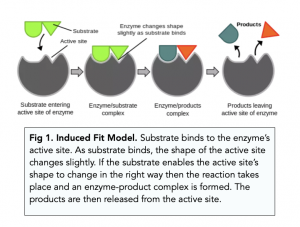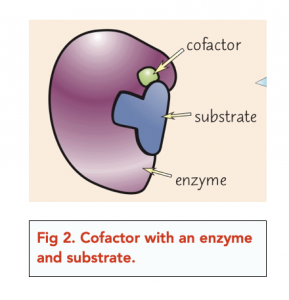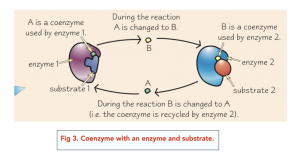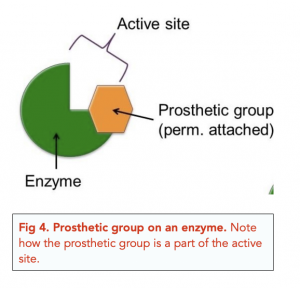Enzymes: Mechanism of Action (A-level Biology)
Enzymes: Mechanism of Action
We now understand that enzymes work by binding to substrates and lowering the activation energy of a reaction. We will now look at how enzymes bind to substrates in more detail.
Models of Enzymatic Function
Substrate binding to an enzyme’s active site is a tightly regulated biochemical process. It is crucial that the right substrate binds to the right enzyme. There are two main models that explain enzyme and substrate binding.
Lock and Key Model
- The lock and key model is simple. Every lock can only be opened by a particular key which matches the lock. In order for the lock to open, the key has to fit into the lock perfectly.
- The enzyme is the lock, and substrate the key. In order for a substrate to bind to the active site of an enzyme, it must have the correct shape which allows it to “fit” into the active site.
Induced Fit Model
While the lock and key model is an excellent starting point for understanding how enzymes work, it’s not entirely complete.
- The lock and key model has limitations. Enzymes are very selective in substrate binding, but many substrates can have similar shapes. With the lock and key theory, this should lead to inappropriate binding. However, enzymes still manage to have a surprisingly high level of specificity, and this is due to the induced fit model.
- The induced fit model involves a two-step verification method. The induced fit model suggest that when a substrate binds to an enzyme’s active site, it causes the active site to change shape as well. For the reaction to happen, the substrate has to change the active site’s shape in the right way. This two-step verification method is widely accepted to be the reason for the high specificity with which enzymes function.

Cofactors, coenzymes, and prosthetic groups
Certain enzymes require an additional component to work. There are three types of these molecules which can help in enzymatic reactions: cofactors, coenzymes, and prosthetic groups.
Cofactors
- Cofactors are non-protein molecules. Cofactors tend to be inorganic molecules or ions. An example would be chloride ions (Cl–) which participates in reactions with amylase, the enzyme that breaks down starch.
- Cofactors are not directly involved in the reaction. The role of cofactors is to help bind the substrate and the enzyme. They are not directly involved in the reaction itself, therefore they do not change or get used up at the end of the reaction.

Coenzymes
- Coenzymes are organic molecules. Unlike cofactors, coenzymes are usually organic molecules. An example would be vitamins, such as Vitamin B that is involved in reactions with carbohydrates, fats, and proteins.
- Coenzymes participate in enzymatic reactions. The role of coenzymes is to help transfer chemical groups between different enzymes. They move between the different enzymes and get changed during the reaction. However, they do not get used up as they are continuously recycled throughout the reaction.

Prosthetic groups
- Prosthetic groups are permanently bound to the enzyme. Unlike cofactors and coenzymes that temporarily participate in enzymatic reactions, prosthetic groups are cofactors that are permanently bound to the enzyme itself. An example would be zinc ions (Zn2+) that serve as a prosthetic group on the enzyme carbonic anhydrase in red blood cells.
- Prosthetic groups are a part of the active site. Prosthetic groups are usually a vital component of the active site. Removing the prosthetic group would damage the enzyme and cause it to become denatured.

Enzymes in Biology are proteins that act as catalysts to speed up chemical reactions in the body. They are essential for many biological processes, such as digestion and metabolic reactions.
The mechanism of action of enzymes is based on the concept of enzyme-substrate specificity. Enzymes have an active site, which is a specific region on the enzyme that binds to the substrate, the molecule that the enzyme acts upon. The active site of the enzyme and the substrate fit together like a lock and key, and the enzyme then catalyses the reaction between the substrate and another molecule.
The shape of the active site is crucial for the activity of enzymes, as it determines the substrate specificity of the enzyme. If the active site of the enzyme changes shape, it can no longer bind to the substrate, and the reaction cannot occur. This is why enzymes are sensitive to changes in temperature, pH, and other environmental conditions, as these changes can alter the shape of the active site.
Enzymes increase the rate of reactions by lowering the activation energy required for the reaction to occur. The active site of the enzyme provides a specific environment that facilitates the reaction, and the close proximity of the substrate and enzyme reduces the amount of energy needed to initiate the reaction.
Enzymes play a key role in metabolic reactions, as they catalyse the chemical reactions that make up the metabolic pathways in the body. By increasing the rate of these reactions, enzymes allow the body to carry out metabolic processes efficiently and at a much faster rate than would be possible without enzymes.
Inhibitors are substances that bind to the active site of the enzyme and prevent it from binding to the substrate. This can reduce or completely stop the activity of the enzyme, depending on the type of inhibitor and its concentration. There are two types of inhibitors, competitive inhibitors, which bind to the active site and prevent substrate binding, and non-competitive inhibitors, which bind to another part of the enzyme and alter its shape, preventing the formation of the enzyme-substrate complex.
Enzymes are crucial for the survival of living organisms, as they facilitate many of the chemical reactions that take place in the body. Without enzymes, many of these reactions would occur too slowly to support life, or not occur at all. Enzymes also play a key role in maintaining homeostasis and supporting growth and reproduction.
Enzymes are closely related to other biological concepts, such as metabolism, biochemical pathways, and the regulation of metabolic processes. Enzymes also play a role in disease and the development of drugs, as inhibitors and activators of enzymes can be used to treat conditions such as diabetes and high cholesterol. Understanding the mechanism of action of enzymes is essential for understanding many biological processes and their regulation.






Still got a question? Leave a comment
Leave a comment